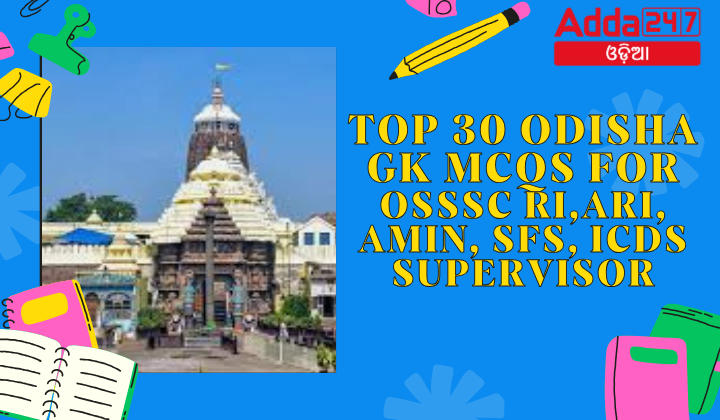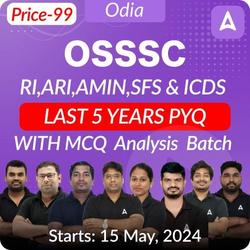General Knowledge is a crucial component of competitive exams, and when it comes to Odisha, a rich tapestry of history, culture, and geography awaits exploration. As you prepare for OSSSC RI, ARI, Amin, SFS, ICDS Supervisor exams, mastering Odisha GK is indispensable. This article presents a curated set of Top 30 Odisha General Knowledge Multiple-Choice Questions (MCQs) to sharpen your knowledge base and boost your exam readiness.
Top 30 Odisha GK MCQS For OSSSC RI,ARI, Amin, SFS, ICDS Supervisor
- During the Somavamshi dynasty, the Mahasandhivigrahika held the position of:
[A] Chief Minister
[B] Commander in chief
[C] Diplomat
[D] Minister of war and peace
Answer: D [Minister of war and peace] - In the Bhauma-Kara period, Odisha had a commercial relationship with which regions?
[A] Ceylon
[B] China
[C] South East Asia
[D] All of the above
Answer: D [All of the above] - What was the role of the Mahakshapatalika during the Somavamshi dynasty?
[A] Chief Minister
[B] Preparing charter
[C] Commander in chief
[D] Minister of war and peace
Answer: B [Preparing charter] - Which industry was most significant during the Bhauma-Kara period?
[A] Agriculture
[B] Cloth manufacturing
[C] Shipbuilding
[D] Pottery
Answer: B [Cloth manufacturing] - What is the primary source of irrigation in Odisha?
[A] Canals
[B] Wells and Tubewells
[C] Tank
[D] None of the above
Answer: B [Wells and Tubewells] - Which lake in Odisha is known for its horse-shoe shape?
[A] Chilika
[B] Kolab
[C] Ansupa
[D] Tampara
Answer: C [Ansupa] - What is the length of Ansupa lake?
[A] 1 km
[B] 3 km
[C] 5 km
[D] 7 km
Answer: C [5 km] - Which of the following is NOT a major source of irrigation in Odisha?
[A] Canals
[B] Wells and Tubewells
[C] Tanks
[D] Rivers
Answer: D [Rivers] - Which river rises from the Amarkantak plateau along with the Narmada, the Son, and Arnadoh?
[A] Narmada
[B] Son
[C] Mahanadi
[D] Arnadoh
Answer: C [Mahanadi] - From which district of Chhattisgarh does the Mahanadi River rise?
[A] Raigarh
[B] Raipur
[C] Dhamtari
[D] Bilaspur
Answer: B [Raipur] - What is the total length of the Mahanadi River before it meets the Bay of Bengal?
[A] 651 km
[B] 751 km
[C] 851 km
[D] 951 km
Answer: C [851 km] - Which of the following is NOT a main tributary of the Mahanadi River?
[A] Seonath
[B] Jonk
[C] Tapti
[D] Mand
Answer: C [Tapti] - Which two states does the Mahanadi River flow through?
[A] Chhattisgarh and Bihar
[B] Chhattisgarh and Odisha
[C] Chhattisgarh and Jharkhand
[D] Chhattisgarh and West Bengal
Answer: B [Chhattisgarh and Odisha] - What is the total length of the Mahanadi River?
[A] 600 kilometers
[B] 750 kilometers
[C] 900 kilometers
[D] 1050 kilometers
Answer: C [900 kilometers] - Which project is associated with the Mahanadi River and was the first major multipurpose river valley project after India’s independence in 1947?
[A] Sardar Sarovar Dam
[B] Bhakra Nangal Dam
[C] Hirakud Dam
[D] Tehri Dam
Answer: C [Hirakud Dam] - What recognition have seven items from Odisha, including Similipal Kai chutney and Kapdaganda shawl, received?
a) UNESCO World Heritage status
b) Geographical Indication (GI) label
c) National Cultural Heritage designation
d) Protected Designation of Origin (PDO) status
Answer: b) Geographical Indication (GI) label - Which unique ingredient is used in the preparation of Similipal Kai chutney?
a) Red chili peppers
b) Red weaver ants
c) Saffron
d) Lemongrass
Answer: b) Red weaver ants - What do the embroidered Kapdaganda shawls represent?
a) Traditional dance forms of Odisha
b) Folk tales from Odisha
c) Cultural heritage of Odisha
d) Religious practices in Odisha
Answer: c) Cultural heritage of Odisha - What distinguishes products with a Geographical Indication (GI) label?
a) They are mass-produced for global markets
b) They are exclusively manufactured by large corporations
c) They are linked to a specific geographical area and possess qualities or a reputation that are due to that origin
d) They are not subject to any quality standards
Answer: c) They are linked to a specific geographical area and possess qualities or a reputation that are due to that origin - Who is responsible for conferring the Geographical Indication (GI) status in India?
a) Ministry of Agriculture and Farmers Welfare
b) Ministry of Food Processing Industries
c) Department for Promotion of Industry and Internal Trade, Ministry of Commerce and Industry
d) Ministry of Textiles
Answer: c) Department for Promotion of Industry and Internal Trade, Ministry of Commerce and Industry - Which factor does NOT determine the characteristics of soil?
a) Parent rock materials
b) Climate
c) Vegetation
d) Population density
Answer: d) Population density - What is the primary reason for the heterogeneity of parent rock materials in Odisha?
a) Volcanic activity
b) Glacial erosion
c) Tectonic movement
d) Weathering and erosion processes
Answer: d) Weathering and erosion processes - Which classification system divides Odisha soils into two groups based on relief features?
a) Topographic classification
b) Climatic classification
c) Formation-based classification
d) Relief-based classification
Answer: d) Relief-based classification - Which soil type in Odisha is characterized by the decomposition of silicate during rain?
a) Laterite Soil
b) Red and Yellow Soil
c) Black Soil
d) Brown Forest Soil
Answer: a) Laterite Soil - What is the predominant characteristic of Black Soil in Odisha?
a) Low pH
b) High nitrogen content
c) Sandy texture
d) Low potassium content
Answer: a) Low pH - Which district in Odisha is NOT mentioned as having Black Soil?
a) Puri
b) Ganjam
c) Keonjhar
d) Sambalpur
Answer: c) Keonjhar - What type of soil is formed by a mixture of eroded materials and is heterogeneous in character?
a) Laterite Soil
b) Residual Soil
c) Red Soil
d) Transported Soil
Answer: d) Transported Soil - What is the primary crop grown in areas with Red and Yellow Soil in Odisha?
a) Wheat
b) Rice
c) Jowar
d) Cotton
Answer: b) Rice - Which soil type covers the largest area of Odisha?
a) Black Soil
b) Red Soil
c) Laterite Soil
d) Brown Forest Soil
Answer: b) Red Soil - Which crop is NOT typically grown in Red Soil areas of Odisha?
a) Rice
b) Finger millets
c) Sugarcane
d) Wheat
Answer: d) Wheat
















